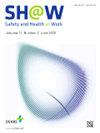Occupational Safety and Health Risks of Informal Waste Workers in Nepal: A Mapping Review
IF 2.9
3区 医学
Q1 PUBLIC, ENVIRONMENTAL & OCCUPATIONAL HEALTH
引用次数: 0
Abstract
Background
Informal waste workers (IWWs) are a crucial yet under-protected worker population. IWWs in low- and middle-income countries encounter numerous occupational safety and health (OSH) hazards but are without regulatory protections. In Nepal, rapid urbanization and inadequate waste management systems have led to thousands of IWWs. The objective of this mapping review is to synthesize the existing literature on OSH hazards encountered by Nepalese IWWs. Evidence on this worker population in Nepal has yet to be summarized and this review highlights practice and research gaps that can inform future evidence-based policies and interventions.
Methods
Inclusion criteria included English language research (1996–2024) exploring OSH risks in Nepalese IWWs. Studies focusing on formal workers, non-Nepalese, or non-OSH outcomes were excluded. Five databases (MEDLINE, Embase, Global Health, CINAHL, and Journals@Ovid) and grey literature (WorldCat, Dimensions, OpenAlex, and Google Scholar) were searched, compiled, and analyzed using Covidence .
Results
A total of N = 6 studies were included in the study (four cross-sectional and two mixed methods) with a total 2,860 participants, predominantly from the Kathmandu Valley in Nepal. High prevalence of physical injury (66.2%), respiratory symptoms (69.9%), elevated blood lead levels (mean: 11.68 μg/dL), and mental health issues (27.4% depressive symptoms) were reported. Similarly, personal protective equipment (PPE) use was limited (32.4%), with IWWs citing cost and discomfort as primary reasons for not using it. Women IWWs were subject to higher mental health risks and social stigma.
Conclusion
Nepalese IWWs are exposed to severe OSH risks driven by systemic neglect. Prioritized interventions include formalization of work, increasing PPE access, and gender-inclusive policies.
尼泊尔非正式废物处理工人的职业安全和健康风险:绘图审查
背景非正规废物处理工人(IWWs)是一个至关重要但保护不足的工人群体。低收入和中等收入国家的外来务工人员面临许多职业安全和健康危害,但没有监管保护。在尼泊尔,快速的城市化和不完善的废物管理系统导致了成千上万的IWWs。这一绘图审查的目的是综合现有的文献关于尼泊尔IWWs遇到的职业安全与健康危害。关于尼泊尔这一工人人口的证据尚未得到总结,本综述突出了实践和研究的差距,可以为未来的循证政策和干预措施提供信息。方法纳入标准为英语语言研究(1996-2024),探讨尼泊尔IWWs的职业安全与健康风险。排除了针对正式工人、非尼泊尔人或非职业安全与卫生结果的研究。使用covid - ence对五个数据库(MEDLINE、Embase、Global Health、CINAHL和Journals@Ovid)和灰色文献(WorldCat、Dimensions、OpenAlex和谷歌Scholar)进行检索、编译和分析。结果本研究共纳入N = 6项研究(4项横断面方法和2项混合方法),共有2,860名参与者,主要来自尼泊尔加德满都谷地。据报道,身体损伤(66.2%)、呼吸系统症状(69.9%)、血铅水平升高(平均11.68 μg/dL)和精神健康问题(27.4%有抑郁症状)的患病率较高。同样,个人防护装备(PPE)的使用有限(32.4%),IWWs认为成本和不适是不使用PPE的主要原因。外籍妇女面临更高的心理健康风险和社会耻辱。结论尼泊尔外来务工人员由于系统疏忽,面临严重的职业安全健康风险。优先干预措施包括工作正规化、增加个人防护装备获取和性别包容政策。
本文章由计算机程序翻译,如有差异,请以英文原文为准。
求助全文
约1分钟内获得全文
求助全文
来源期刊

Safety and Health at Work
Social Sciences-Safety Research
CiteScore
6.40
自引率
5.70%
发文量
1080
审稿时长
38 days
期刊介绍:
Safety and Health at Work (SH@W) is an international, peer-reviewed, interdisciplinary journal published quarterly in English beginning in 2010. The journal is aimed at providing grounds for the exchange of ideas and data developed through research experience in the broad field of occupational health and safety. Articles may deal with scientific research to improve workers'' health and safety by eliminating occupational accidents and diseases, pursuing a better working life, and creating a safe and comfortable working environment. The journal focuses primarily on original articles across the whole scope of occupational health and safety, but also welcomes up-to-date review papers and short communications and commentaries on urgent issues and case studies on unique epidemiological survey, methods of accident investigation, and analysis. High priority will be given to articles on occupational epidemiology, medicine, hygiene, toxicology, nursing and health services, work safety, ergonomics, work organization, engineering of safety (mechanical, electrical, chemical, and construction), safety management and policy, and studies related to economic evaluation and its social policy and organizational aspects. Its abbreviated title is Saf Health Work.
 求助内容:
求助内容: 应助结果提醒方式:
应助结果提醒方式:


